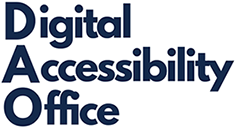Captions
What are captions?
Captions are the text version of the audio information in a video or animation. The text synchronizes with the video’s action. They include all spoken words, identification of the speaker, and important sounds likes music or laughter.
Types of captions
Closed captions can be turned on and off by viewers as needed. They get added to videos by a separate captioning file format (e.g. SRT, webVTT, etc.). Depending on the video player, users can adjust the font size and style of closed captions to suit their individual needs.
Open captions always appear in the video because they are part of the video itself. Viewers cannot turn them off. They allow video editors flexibility in placement and style.
When are captions required?
All pre-recorded and live videos must include captions. Depending on the needs of your viewers, you may use automatic captions for live video events. Keep in mind automatic captions are never accurate. For example, you can use YouTube’s automated captions as a starting point when adding closed captions to a pre-recorded video. Or you may turn on Zoom’s live transcripts for automatic captions during your next meeting or event.
Impact on users
Captions benefit users who are deaf or have hearing loss, but they also help all users understand and remember information.
Captioning best practices
We recommend signing up for our Captioning training to learn more about the ins and outs of captioning.
Accuracy
Make sure your captions include punctuation, correct spellings of words, and don’t change what the speaker says. Adding or deleting words can change the original meaning of the video’s content.
Note: it is okay to remove filler words like “um” if they don’t contribute to the video’s meaning.
Speaker identification
Tell your viewer who is speaking. Consider using the following formatting when labeling speakers:
- Bold text
- >> Speaker Name
- If the speaker is unknown, use Speaker 1, Speaker 2, Speaker 3, etc. as identifiers
Sound descriptions
Some sounds can have significant impact in the video like a sarcastic tone or music during a joyful moment. Add them to the captions and transcript using the following formatting:
- Use [ ] to surround the audio description
- [sarcastically] Sure.
- [Upbeat music playing]
Recommended resources
Need help?
If you have questions or concerns, you can submit an online help request for a consultation with the Digital Accessibility Office.
